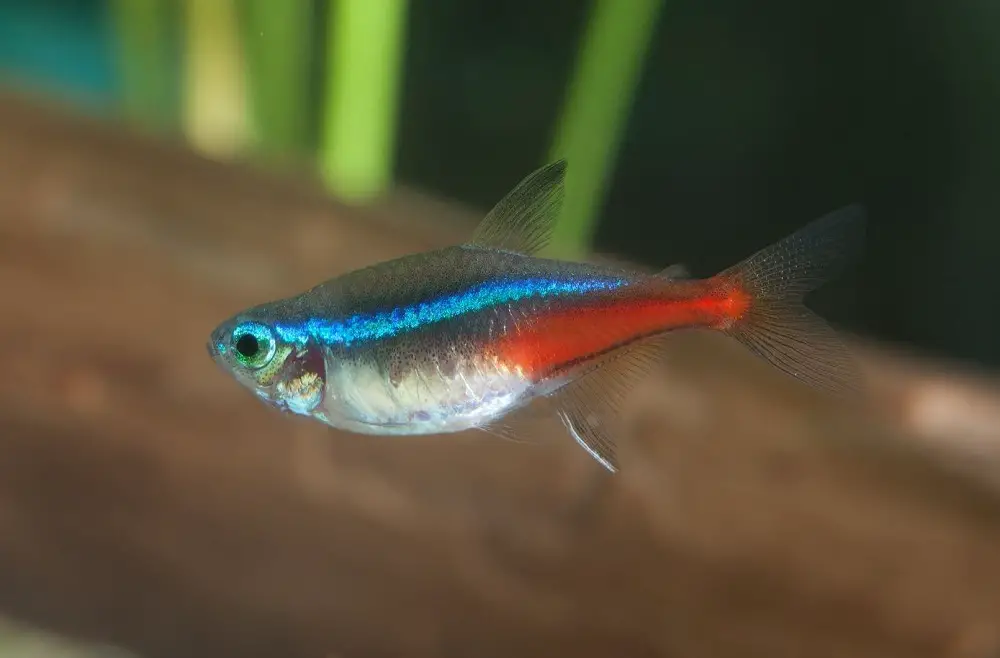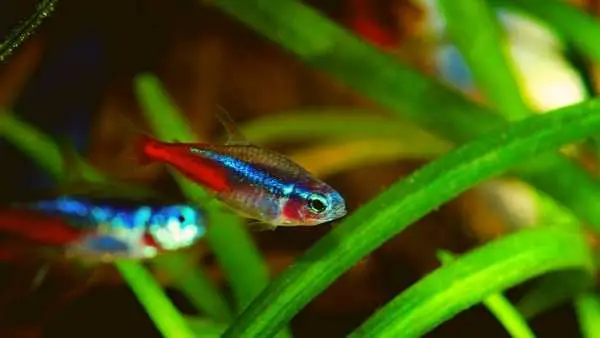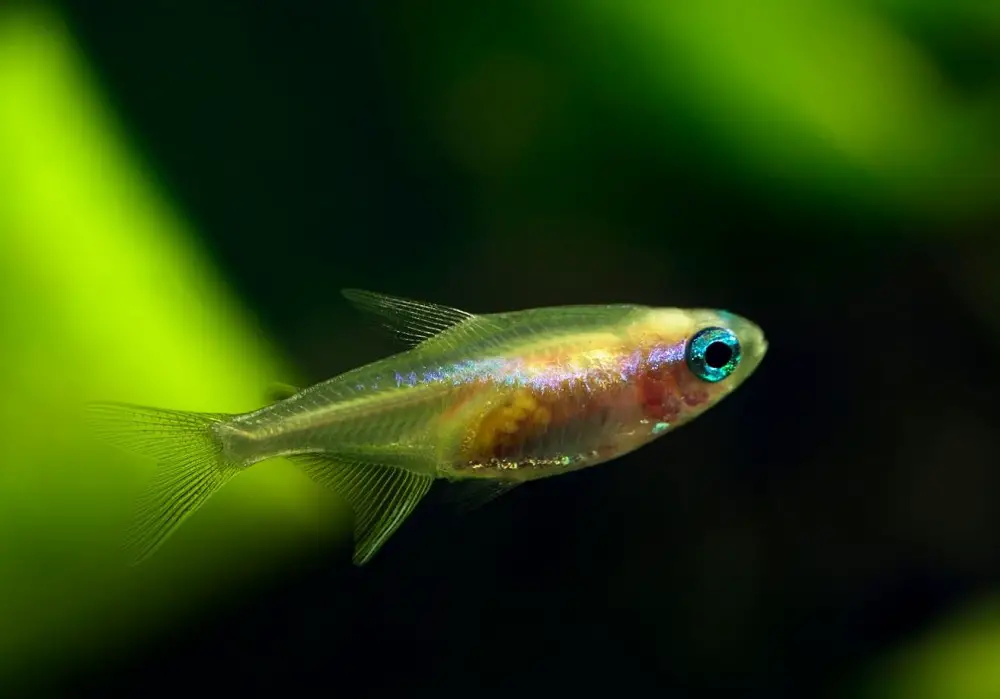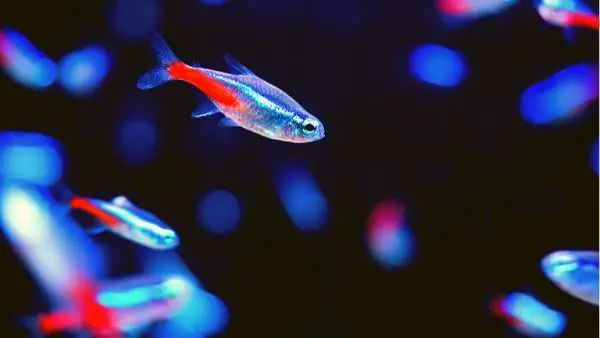You’ve created the perfect tank for your neon tetra fish. The soft lighting and living plants give your beautiful neon tetras the ideal tank environment so that they can flourish.
While you’re standing admiring your lovely tank, you can’t help but notice that one of your fish seems to have a larger belly than some of the others. Is it possible that your neon tetra fish might be pregnant?
Sadly, your fish isn’t pregnant. Neon tetras are an egg spawning species, which means that the larger belly of your fish could mean she’s carrying eggs and is possibly about to spawn.
Today we’re going to help you work out if your fish is actually carrying eggs, as well as show you how to care for your pregnant neon tetra and her fry!

How to tell the difference between male and female neon tetras
Before you start to get excited about the idea of baby fry in your tanks, you’ll need to know which fish are the males and which are the females. So you’ll need to observe them carefully to distinguish between them.
Male neon tetras typically have:
- Leaner bodies
- Brighter, more vibrant colors
- Lengthy anal and dorsal fins
- Horizontal neon blue line
Female neon tetras typically have:
- Larger, longer bodies
- Curvy body shape
- Duller colors
- Smaller anal and dorsal fins
- Larger diagonal neon blue line
Note changes of behavior and appearance
So now we know how to tell the male and female neon tetra fish apart. So this should allow you to identify if your female neon tetras have any physical changes to their appearance. If they have a more swollen belly, chances are that they’re carrying eggs.
Another indicator that your neon tetras might be ready to breed is in how the males behave. Males tend to try and court the females, and will display behavior which can give the game away. If you spot any male tetras swimming in a square pattern, with jumpy movements, freezing quickly before continuing to swim, this could indicate that they are trying to court a female.
Pairs of fish that separate themselves from the rest of school could likely be ready to breed, too. They tend to swim a little bit away from the rest of the fish.
Do you want to breed fish?
Don’t plan on actually breeding your fish? Then you don’t have to do anything other than observe your tank. This is because the eggs and fry from your egg-bearing female neon tetra will be eaten by the other fish in your tank if you don’t move her. This is typically what you will need to do for other pregnant fish that you own.
If you do want to breed from your neon tetras, then it’s worth doing a bit of research. The best way to ensure that your fish survive is to prepare for their arrival! We’ll cover a few of the breeding basics below.

Breeding basics
Most importantly you will need a separate breeding tank for your fish. This should be smaller than your normal tank. A 5 to 10 gallon tank should be just fine.
In your new tank, you will need to give it a dark, sandy bottom, as well as add some live plants and moss. A spawning mop will be a great addition as this will give the female neon tetra somewhere to lay her eggs. The fry will also be light sensitive, so this should shade them. You will also need to control the light in the tank because of this.
Water temperature should be around 70℉ to 81℉, and a temperature of around 78℉ will help to encourage spawning.
Your water should be conditioned, filtered, and soft. It should be slightly acidic without any ammonia, nitrate, or nitrate contamination. Try and keep the pH level around 6.0 or 7.0 if you can. Any drastic changes to the chemistry of your water could prove fatal for the neon tetra, her eggs, and the fry.
Once your tank is ready, you can place the breeding pair into it.
Choose the right food
One of the most important factors for ensuring that your fish breed is to feed them the right food. It will need to be high quality food that’s either live or high in protein. Bloodworms, brine shrimp, and Daphnia will be ideal.
These foods are important because they will give your neon tetras the balanced diet they need. They should also give them all the necessary vitamins and minerals they need to increase the health of your entire tank.
Look for fish eggs
Frustratingly, neon tetra eggs can be quite tricky to see. They are typically round, small, and will be either yellow or clear white. You should be able to see them stuck on plant leaves or moss, or even on the sandy floor of your tank.
Did you know that a single female neon tetra can lay as many as 60 to 130 eggs? These typically take around 24 hours to hatch. Once you have spotted the eggs, these have likely been fertilized. You should then remove the adults from the tank and place them back into their main tank.
If you leave the adult fish in the tank, they will likely eat the eggs and the fry once they’ve hatched. You should be able to spot the small fry once they have hatched. They should appear like small, tiny shards of glass drifting around the tank.
Have a large enough tank in place
Now that you have successfully bred your neon tetras, you will want to ensure that they reach maturity. So they will need to have a properly sized tank for them to grow into adulthood.
A 10 gallon tank will be ideal for rearing a large batch of freshly hatched fry. However, they will need more room once they start to grow. You can generally raise around 20 to 30 fry successfully in a 10 gallon tank. When they become mature, you will need to move the young fish into your main tank, or give them away to family and friends.
How to care for baby fry

Feeding
Once your neon tetra eggs have hatched, you will need to wait around 5 days or so before you add a small amount of food to their tank. You should use the right kind of food for your smaller fish, so choosing smaller food sources will be essential. Green water or vinegar eels will be ideal as the fry will find it easier to eat the smaller particles.
It is possible to buy commercial fry foods, however, live food is better for younger fish. You should save the larger foods such as brine shrimp and micro worms until the neon tetra fry are around 2 to 3 weeks old. Once they have reached this age you can give them several small feedings each day to help promote their growth.
Water changes
It’s important to remember never to change the water of your breeding tank during the first week of your fry’s lives. Once a week has passed, you can change a small amount of water. This should be around 10% to 15% of the water.
When your fry reaches 2 or 3 weeks old you can start to change more water. You should then perform a 30% water change daily.
Lighting
The lighting of your breeding tank will be important, especially during the first 48 hours. You must keep the light switched off for this time to allow the neon tetra eggs to hatch, and for the larvae to develop into free-swimming fry. Once the fry have developed, you can then keep the light on low.

In summary
So there you have it! We now know that if your female neon tetra fish is looking larger than normal, she isn’t pregnant. However, she could be about to spawn eggs! If you do decide that you want to breed your neon tetras, it’s important to do your research beforehand.
You will need to have properly prepared your tanks beforehand, otherwise the fry likely won’t survive. It’s also important to remember to separate your breeding pair from the rest of your tank otherwise the eggs and fry will get eaten. It’s also generally a good idea to follow the advice of successful breeders, as they’ll be able to give you the best tips for success!
If you follow our advice above, you should be able to successfully breed your neon tetras and admire the young fish swimming around your tank.
